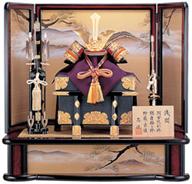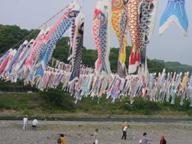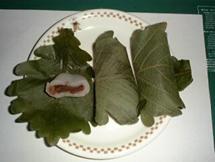JAPAN: Kodomo no hi (meaning "Childrens Day) /May 5
Kodomo no hi (meaning "Children’s Day) is a Japanese national holiday which takes place annually on May 5, the fifth day of the fifth month, during the Golden Week (meaning long vacation) period. It is a day set aside to respect children's personalities and to celebrate their happiness.
In my family, boys are celebrated in this festival because Hinamatsuri is for girls.Generally speaking this festival is for boys and girls.
On this day, families raise the carp-haped Koinobori flags, one for each boy (or child), and display the doll of Kintarou usually riding on a large carp, and the traditional Japanese military helmet, Kabuto.
Kintarou and the Kabuto are both symbols of a strong and healthy boy. Kintarou is the childhood name of Sakata no Kintoki who was a hero in the Heian period, a subordinate samurai of Minamoto no Raikou, having been famous for his strength when he was a child in Japan. It is said that Kintarou mounted on a bear, instead of a horse, and played with animals in the mountain when he was a young boy. Mochi rice cakes wrapped in kashiwa oak leaves, that is, kashiwa-mochi and chimaki, are traditionally served on this day.
In my family, boys are celebrated in this festival because Hinamatsuri is for girls.Generally speaking this festival is for boys and girls.
On this day, families raise the carp-haped Koinobori flags, one for each boy (or child), and display the doll of Kintarou usually riding on a large carp, and the traditional Japanese military helmet, Kabuto.
Kintarou and the Kabuto are both symbols of a strong and healthy boy. Kintarou is the childhood name of Sakata no Kintoki who was a hero in the Heian period, a subordinate samurai of Minamoto no Raikou, having been famous for his strength when he was a child in Japan. It is said that Kintarou mounted on a bear, instead of a horse, and played with animals in the mountain when he was a young boy. Mochi rice cakes wrapped in kashiwa oak leaves, that is, kashiwa-mochi and chimaki, are traditionally served on this day.
Tango no Sekku..
It was originally called Tango no Sekku (端午の節句), which may originally be the Chinese Dragon Boat Festival.
Sekku means a season's festival (there are nowadays five Sekku per year). This one was considered to mark the beginning of the summer or of the rainy season. Tango has a double meaning: Tan means "edge""first" and go means "noon". In Japanese go also means five , which could refer to the date of the festival being the fifth day of the fifth month. From the beginning of history, the fifth month of the Chinese calendar was said to be a month for purification, and many rites that were said to drive away evil spirits were performed in this month.
Although it is not known precisely when this day started to be celebrated, it was probably during the reign of the Empress Suiko (593-628 A.D.). In Japan, Tango no Sekku was assigned to the 5th day of the 5th month after the Nara period. Until recently, Tango no Sekku was known as Boys' Day (also known as Feast of Banners) while Girls' Day (Hinamatsuri) was celebrated on March 3. In 1948, the government decreed this day to be a national holiday to celebrate the happiness of all children and to express gratitude towards mothers. It was then renamed Kodomo no hi. There is some disgruntlement that, despite its renaming, it is still Boys' Day and it is inappropriate that Boys' Day is a national holiday, while Girls' Day on March 3 is not a national holiday.
My family doesn’t set kabuto and the carp-haped Koinobori flags because of tronblesome… my mother said.
Ikuyo Miyuki
Sekku means a season's festival (there are nowadays five Sekku per year). This one was considered to mark the beginning of the summer or of the rainy season. Tango has a double meaning: Tan means "edge""first" and go means "noon". In Japanese go also means five , which could refer to the date of the festival being the fifth day of the fifth month. From the beginning of history, the fifth month of the Chinese calendar was said to be a month for purification, and many rites that were said to drive away evil spirits were performed in this month.
Although it is not known precisely when this day started to be celebrated, it was probably during the reign of the Empress Suiko (593-628 A.D.). In Japan, Tango no Sekku was assigned to the 5th day of the 5th month after the Nara period. Until recently, Tango no Sekku was known as Boys' Day (also known as Feast of Banners) while Girls' Day (Hinamatsuri) was celebrated on March 3. In 1948, the government decreed this day to be a national holiday to celebrate the happiness of all children and to express gratitude towards mothers. It was then renamed Kodomo no hi. There is some disgruntlement that, despite its renaming, it is still Boys' Day and it is inappropriate that Boys' Day is a national holiday, while Girls' Day on March 3 is not a national holiday.
My family doesn’t set kabuto and the carp-haped Koinobori flags because of tronblesome… my mother said.
Ikuyo Miyuki


